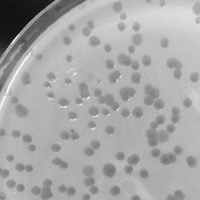Gordonia phage Ascisco
Add or modify phage thumbnail images to appear at the top of this page.
Know something about this phage that we don't? Modify its data.
| Detailed Information for Phage Ascisco | |
| Discovery Information | |
| Isolation Host | Gordonia terrae 3612 |
| Found By | Tucker Pavelek |
| Year Found | 2016 |
| Location Found | Pittsburgh, PA USA |
| Finding Institution | University of Pittsburgh |
| Program | Science Education Alliance-Phage Hunters Advancing Genomics and Evolutionary Science |
| From enriched soil sample? | Yes |
| Isolation Temperature | 30°C |
| GPS Coordinates | 40.265 N, 79.5714 W Map |
| Discovery Notes | The phage was isolated from soil found in a flower bed near McCormick residence hall in Pittsburgh, PA. It was isolated via enriched isolation. The soil was fertile and supported flower growth. The area was well-irrigated. The soil was slightly clumpy and contained organic plant matter including roots and mulch. |
| Naming Notes | The phage was named Ascisco, which means "I receive" in Latin. I was very glad the phage was discovered and felt like it was a gift. Because I was grateful to have found a phage, I decided to name it Ascisco. |
| Sequencing Information | |
| Sequencing Complete? | No |
| Genome length (bp) | Unknown |
| Character of genome ends | Unknown |
| Fasta file available? | No |
| Characterization | |
| Cluster | Unclustered |
| Subcluster | -- |
| Lysogeny Notes | The phage utilizes the lytic method of infection. |
| Annotating Institution | Unknown or unassigned |
| Annotation Status | Not sequenced |
| Plaque Notes | The plaques formed by Ascisco are round, about 1mm to 2.5mm in diameter, and are clear. They are "haloed," containing dark spots in the middle of the plaque and a lighter ring around the edge. Because the phage produces two distinct types of plaques, it is said to have a mixed morphology. |
| Has been Phamerated? | No |
| Publication Info | |
| Uploaded to GenBank? | No |
| GenBank Accession | None yet |
| Refseq Number | None yet |
| Archiving Info | |
| Archiving status | Archived |
| SEA Lysate Titer | 3x10^10 |
| Pitt Freezer Box# | 42 |
| Pitt Freezer Box Grid# | B5 |
| Available Files | |
| Plaque Picture | Download |
| Restriction Digest Picture | Download |
| EM Picture | Download |
